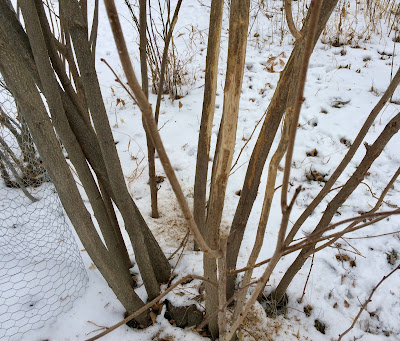Storage and care of hazelnuts
Hazelnuts have a high oil content, usually between 20% and 50% and when exposed to air (oxygen) they will become rancid in just a few weeks. They should be kept in a cool dry place and if shelled eaten as soon as possible or stored in the freezer.
The first step is to pick the hazelnuts when they are ripe. If the nut is picked too early the husk will never release the nut even when dried down and nuts that are picked too late will be taken by squirrels and a dozen other animals. The best time is when the nut rolls easily out of the husk. This test should be done on 2 or 3 different places on the plant.
They are then stored in bags until I place them on the drying racks. This usually takes about 3 days. If I still have no room on the drying racks after a couple days I will put them in mesh bags. They need some type of air flow to dry down or they will become moldy if left in any type of enclosed bag.
The plant you see in the background was beat up by a buck last week.
I'll show more of that later.
Drying down the husk is the next step. This takes about a week. If they are dried down too fast the nut will crack and kernel will become rancid in 2 or 3 weeks.
When the husks are dry enough they are placed in a bucket and I use a drill with a paint mixer and 2 added weights to separate the nuts from the husk.
I then use the aspiration system you see above to your left to separate the nuts from the husks.
The nuts are placed in mesh bags and are stored a cool dry place (refrigerater) until they are shelled. They will last about 3 months in the fridge before becoming rancid. When stored in a freezer
they will remain in good condition for up to a year. The sealed bags below are the nuts I'm stratifying in peat for my next years seedlings that I'll germinate in March.
I next separate the nuts into 10 different sizes to make it easier to run them through the nut cracker.
This is my drill cracker that I use to crack the hazelnuts. I start by cracking the larger nuts and then adjust it a little smaller for each of the 10 different sizes. I do this to try to obtain a whole kernel after the nut cracks.
Here you can see the cracked shells and kernels as I start to run them though the aspiration system.
This is my shop vac aspiration system that I use to remove the shells from the kernels.
This is also the same one I use for separating the nuts from the husks.
After the shells have been removed I place them in sealed bags.
The bags are then placed in the freezer next to the lefse.
The shelled meats (kernels) will last up to 3 months in the freezer in sealed bags. I have left them in the freezer for 6 months and they where still in fair shape.
We try to use them as soon as possible for making hazelnut butter, granola, candied nuts, roasted, and raw on my cereal in the morning.
If you like roasted hazelnuts without burning them, the kernels should be roasted for 5 to 10 minutes at 350º F. The smaller kernels are roasted for no more then 5 minutes or they will taste burnt.
A buck deer has been at it again 😬
I noticed a buck starting to rub off the bark on one stem.
The next day I went out to put a cage around the plant and found this. I did put the cage up but it was a little late.
This is that same hazelnut plant looking at it from the other side.
In search of hazelnuts
I've found hazelnuts in many locations around North Dakota, Minnesota and many other states.
The plants here were found south of Kathryn, ND along a creek flowing into the Sheyenne River.
These hazelnut plants where located near Pequot Lakes, MN.
We toured this hazelnut orchard in Oregon.
The hazelnut here I found in southern Tasmania.
This one I found in Vancouver growing next to a sidewalk when out for a walk.
Kathy Wiederholt has these hazelnuts growing in Carrington at the CREC hardy fruit evaluation project.
Kathy does a great job evaluating plants for North Dakota.
Don't miss their field day.





















Really cool post! I like all the picture!
ReplyDeleteThanks:)
Delete